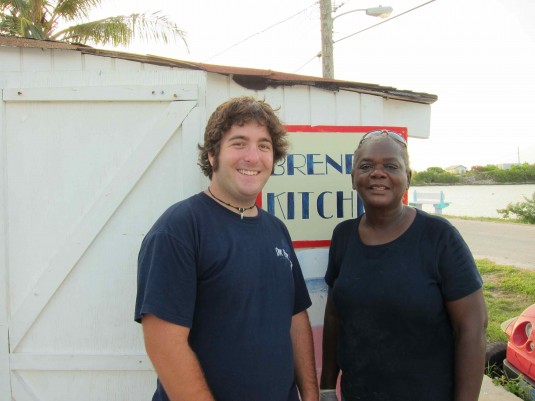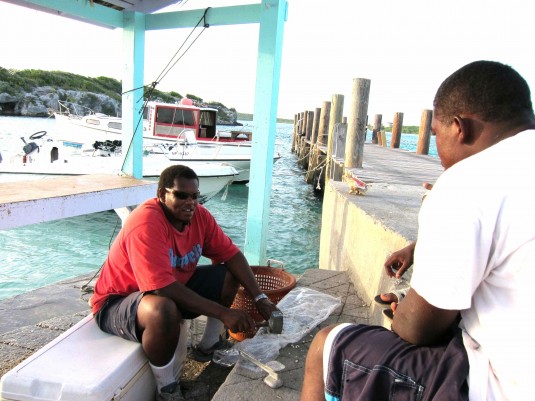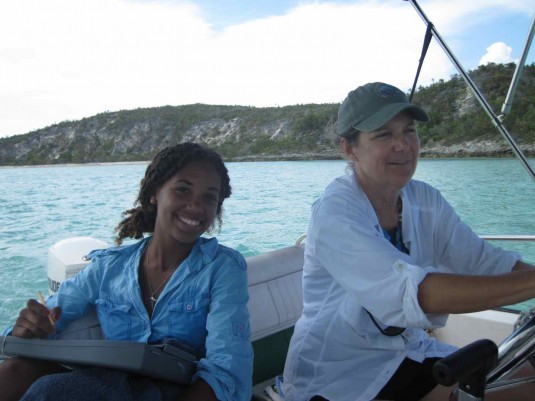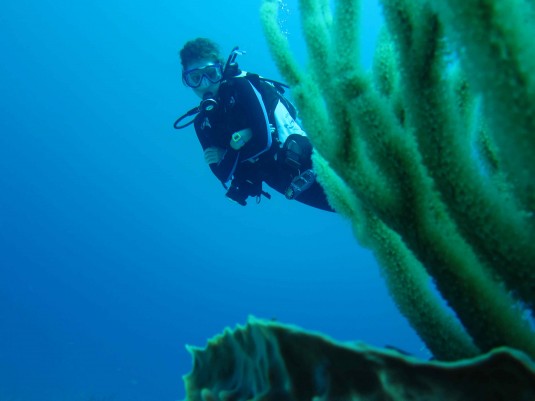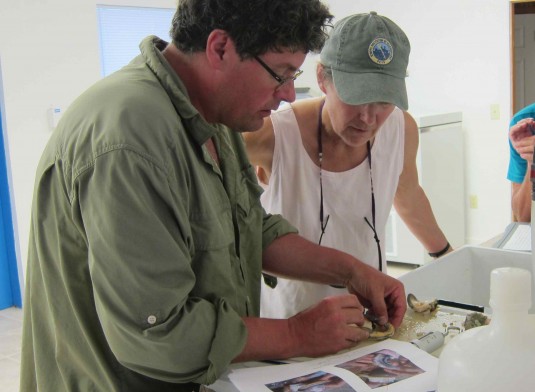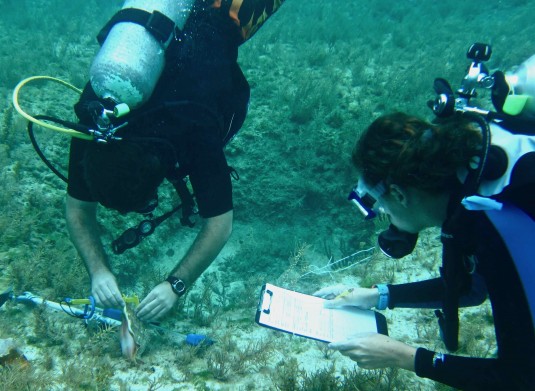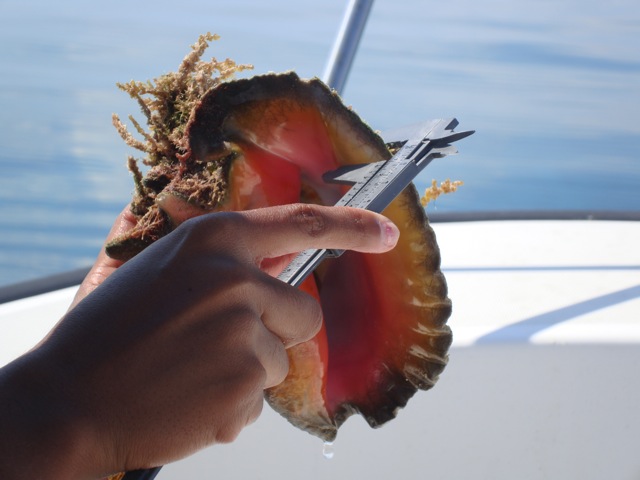(NASSAU, BAHAMAS) – This summer a team of scientists and volunteers will conduct important surveys of queen conch populations in the Exuma Cays of The Bahamas. Community Conch, a U.S. non-profit organization, has organized this year’s expedition. It is their third conch survey in the country since 2009. With support from the Department of Marine Resources, the Bahamas National Trust, and the Perry Institute for Marine Science, the group will look closely at conch populations in two areas that were surveyed nearly 20 years ago to document trends in the numbers and reproductive success of this economically and ecologically important species.
The queen conch is known to scientists as Strombus gigas, and throughout the Caribbean by a variety of names such as the pink conch, the broad-lipped conch, karkó, lambi, and the giant conch. Queen conch has been an important staple in the diet of many Caribbean cultures and a seafood delicacy for tourists, but unfortunately the species is threatened throughout its range and is already commercially extinct in many countries including the United States. Because of diminishing stocks throughout the Caribbean, the queen conch is protected through export restrictions imposed by the Convention on International Trade in Endangered Species of Wild Fauna and Flora (CITES).
The Bahamas is no exception. Despite national and international regulation of the fishery, queen conch populations are disappearing here too. In many places where an abundance of conchs were once found, there are few if any left, especially in the coastal waters that are easily fished. According to the most experienced fishermen, at one time it seemed that there was an endless supply of the tasty marine snail, but those times have passed. To find enough for a commercial harvest, fishermen must now travel farther than ever before. On some of the more populated islands it is often difficult to find even a few for the dinner table. Bahamian fishery regulations prohibit the taking of conchs without a flared lip, but illegal harvest of juvenile or undersized conchs is still widely practiced.
So, what can be done to protect the queen conch in The Bahamas and ensure a viable fishery in the future? How can the country sustain a commercial fishery without overly depleting such a valuable natural resource? What will be the costs and benefits to the fishing community and to the people of The Bahamas?
Community Conch and the Department of Marine Resources (DMR) are searching for answers to these questions, as are other conservation organizations in The Bahamas and throughout the Caribbean. A first step is to find out where healthy populations still exist and where protection may be needed. Scientists are particularly concerned with the density of conchs in an area, or the number of individuals per hectare, because higher densities of adult conchs are needed for the successful mating seasons that replenish stocks. In 2009, Community Conch and DMR completed the first large scale stock assessment of a commercial conch fishing ground in the Berry Islands and a baseline survey of conch populations within the new Berry Island Marine Reserve. In 2010, Community Conch continued their work with The Nature Conservancy in the traditional fishing grounds of Andros. Sadly, in both locations, the densities were already too low for reproduction, though there were still higher densities of small, commercially undesirable “samba” conchs.
This year during the conch mating season, Community Conch plans to revisit areas in the Exuma Cays that were surveyed in the mid 1990s by Dr. Allan Stoner, who is now the lead scientist for the organization. One of the survey areas is within the Exuma Cays Land and Sea Park, known for being the oldest no-take marine reserve in the world. The other survey area is near Great Exuma and was once a very productive fishing ground for local communities. Nearly 20 years ago, the original surveys of these locations showed that the density of adult conch in the Exuma Park was 31 times higher than that in the fishing ground just north of Great Exuma; even back then it seemed that fishing had started to take its toll.
Dr. Stoner expects that the upcoming surveys in the Exuma Cays will provide important new information about how densities of conch may be changing in these fished and unfished (no-take) areas. “It will be really important to see how the Exuma Cays Land and Sea Park has been functioning as a conch reserve over time,” he says. “Since conch larvae drift for about three weeks before settling in a new location, it is not known if the larvae produced in the Park stay in the park or settle downstream. So, if populations are depleted upstream of the park, it is possible that the density of conch in the Park could decline along with populations outside the Park. This year’s studies are designed to address these questions, and will provide new information critical for conch conservation.”
Martha Davis, Community Conch’s founder and director, elaborates on a second goal for the 2011 expedition: to determine a better estimate of when in the life of a queen conch it is able to mate and lay eggs, a stage in the life cycle also known as reproductive maturity. “We know that near its third year, a conch starts to form a flared lip on its shell and at this point, the shell grows no longer, only thicker. Scientists have proven that the thickness of this lip is related to the conch’s age,” she explains. In The Bahamas, regulation of the conch fishery was based upon the belief that when a conch has a flared lip, it is mature and has had the opportunity to reproduce before being harvested. Ms. Davis suggests that while this has been the criterion used historically, there is more current scientific evidence that shows a flared lip may not be the best indicator of adulthood or reproductive maturity. “Thin-lipped conch may not reproduce until the following summer season, so they could actually be harvested before they reproduce. We need to find out how thick the conch’s lip is when it is capable of reproducing.”
Community Conch relies on committed volunteers from The Bahamas and the U.S for their field studies. This year the organization will be joined by three Bahamian students eager to gain experience in marine science and conservation. While in the Exumas, members of the expedition plan to meet with community members to share and discuss conch conservation issues.
About Community Conch:
The mission of Community Conch is to affect sustainable harvest of queen conch through research, education and collaboration with local communities, the Bahamian government and other non-governmental organizations (NGOs). The organization welcomes comments and suggestions, and shares information with the public via their website www.communityconch.org.
Media Contact
Catherine Booker
Scientist and Field Representative
242-357-0134
catherinebooker@communityconch.org
###


